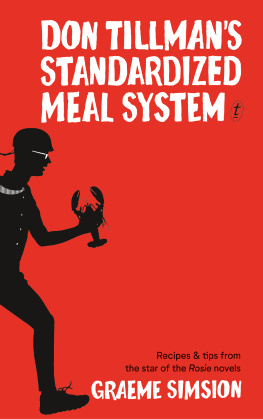So, you cook this same meal every Tuesday, right?
Correct. I listed the eight major advantages of the Standardised Meal System.
1. No need to accumulate recipe books.
2. Standard shopping listhence very efficient shopping.
3. Almost zero wastenothing in the refrigerator or pantry unless required for one of the recipes.
4. Diet planned and nutritionally balanced in advance.
5. No time wasted wondering what to cook.
6. No mistakes, no unpleasant surprises.
7. Excellent food, superior to most restaurants at a much lower price (see point 3).
8. Minimal cognitive load required.
Cognitive load?
The cooking procedures are in my cerebellumvirtually no conscious effort is required.
Like riding a bike.
Correct.
Here at last, by popular demand, is the weekly system of food preparation that Professor Don Tillman, star of the Rosie trilogy, lives byeverything from his signature lobster salad to the worlds best risotto, across the four seasons. This essential guide also includes handy tips about losing weight, mixing cocktails and stress-free entertaining.
Don Tillmans Standardized Meal System will not only show you how to make delicious meals: it will open your mind a different way of shopping, cooking and living. The Don Tillman way.
Contents
So, you cook this same meal every Tuesday, right?
Correct. I listed the eight major advantages of the Standardized Meal System.
1. No need to accumulate recipe books.
2. Standard shopping list hence very efficient shopping.
3. Almost zero waste nothing in the refrigerator or pantry unless required for one of the recipes.
4. Diet planned and nutritionally balanced in advance.
5. No time wasted wondering what to cook.
6. No mistakes, no unpleasant surprises.
7. Excellent food, superior to most restaurants at a much lower price (see point3).
8. Minimal cognitive load required.
On my first date with Rosie Jarman, the woman who would, incredibly, become my (remainder of) life partner, I was unsure of her retention capabilities and selected the number of items according to Millers (1956) seven plus or minus two rule. Had I known she was at the high end of neurotypical memory function, I would have added:
9. Rationalization of kitchen equipment no cupboards and drawers full of items that are hardly ever used. The financial savings allow me to own a smaller set of high-quality cooking tools and invest in leading-edge barbecue technology.
10. Ability to optimize recipes, quantities, and cooking times through continuous feedback.
I would not have added Improved mental health through reduced anxiety and the comfort of routine, as I was not conscious of that benefit at the time.
Nor was I aware of the disadvantages of the Standardized Meal System. Rosie and our son, Hudson, filled that gap in my knowledge. The problems included (note past tense):
1. Failure to accommodate a partner who did not want to eat lobster every Tuesday. After my first attempt at rectifying the problem, Rosie clarified that this quite clear and specific statement was to be interpreted as not wanting any immutable meal assigned to any day of the week, and certainly not forever.
2. No allowance for partners, childs, or guests food preferences, allergies, or ethical restrictions.
3. Perception of the Standardized Meal System as a symptom of rigidity rather than efficiency.
4. Inability to expose a child (or adult) to a wide variety of foods.
5. No allowance for random, short-notice decisions by partner to invite guests or eat out.
6. No contingency plan in the event of disasters such as unavailability of a key ingredient, child-related crisis, or university meeting scheduled during time allocated for shopping or cooking.
7. No process for ongoing evolution of the system.
All problems have now been solved. In the case of item 3, no change to the system was required; instead, I stopped worrying about what unrelated people thought of me. Virtually all meals now allow for variants; no meal is current for more than thirteen weeks (a season); emergencies and dining out are explicitly catered for;and there is provision for both incremental improvement and the introduction of new meals.
Also, since the publication of the three Rosie memoirs, multiple people have contacted me, not to call me rigid or boring or obsessive, but seeking details of how to implement the Standardized Meal System. Hence this book, applying thirty-six years of experience and feedback to what was already an excellent design.
I recommend this fully revised Standardized Meal System as a tool for modifying the behavior of people who irrationally and compulsively devote unnecessary resources to food shopping, meal design, and cooking, with consequent negative impact on their performance in social, occupational, or other important areas.

The principles behind the Standardized Meal System are simple:
1. A standard menu for each week of each season (I recommend commencing on the Saturday closest to the first day of the season).
2. Lunches not specified, except for Saturdays. Weekday lunches are purchased at work or sourced from deliberate creation of leftovers. Sunday brunch is eaten at a cafe or replaced by a late breakfast.
3. Consistent breakfast throughout the year (with seasonal fruit adjustments).
4. Recipes (except for guest nights refer item 7) are for two people but readily scaled up or down (number chosen to facilitate scaling calculations for people who are incompetent at mental arithmetic).
5. Two shopping expeditions (Tuesday and Saturday) each week, using standardized shopping lists for each season.
6. Common Resources (e.g. salt, lemons, tequila) purchased in economic quantities and added to the shopping list when the last container is opened or the quantity remaining is insufficient for the next meal. Purchases can be made at other times to take advantage of discounts.
7. Tuesday is guest night. Recipes allow for four people, i.e. two guests (optimum). A weekday is nominated, as invitees are less likely to have conflicting dining-out commitments and it supports the social convention of announcing Its a school night when you want guests to leave.
8. Friday is restaurant night. An alternative (typically frozen) meal is available as backup if you decide to eat at home. These backup meals can also be used in emergencies.
9. Sunday is the major cooking day for replenishing resources such as chicken stock and frozen meals, and preparing for the week ahead.
10. Alcohol is specified on Saturday, Tuesday, and Friday nights. If you dont drink alcohol or want to drink less (or more), this is easily varied.
11. The menus and schedule should be seen as a starting point for tailoring to include your own dietary rules, food preferences, and quantities.
______
I do not recommend drinking more. I do not recommend drinking alcohol at all.

1. Very important: the adjective approximately can be inserted into all recipes, wherever it will reduce effort and stress. I incurred incredible amounts of both before learning this fact, which applies to sizes, shapes, quantities, and timings. Precision is necessary only in baking (bread, biscuits, cakes which do not feature in this book, with the exception of gougres on Winter Tuesday). Otherwise, variation of 20%, and even the omission of one or two ingredients not included in the name of the recipe, is almost always acceptable.
















